|
Author
|
Topic: Mercury hatch plunger and control sticks
|
Explorer1
Member Posts: 180
From: Los Angeles, CA, USA
Registered: Apr 2019
|
 posted 05-07-2019 06:38 AM
posted 05-07-2019 06:38 AM
  
Mercury-Redstone 4 (Liberty Bell 7) was the first spacecraft to have a hatch that opened with exploding bolts. The bolts were activated with a plunger mechanism that needed to be struck by the palm of the astronaut's hand. Does anyone know where this plunger mechanism was located? Was it on the hatch itself or on the instrument panel of the spacecraft.Secondly, is it true that the Mercury spacecraft was equipped with not one but two "joysticks" (hand held control stick also called "three-axis side arm controller") for controlling the spacecraft's attitude and possibly other functions? I am sure that pitch and yaw were handled by one of the sticks (possibly the left stick). Does anyone know what control functions were distributed between the two sticks? |
Jim Behling
Member Posts: 1488
From: Cape Canaveral, FL
Registered: Mar 2010
|
 posted 05-07-2019 08:13 AM
posted 05-07-2019 08:13 AM
   
Vostok had an explosive hatch. The plunger was on the Mercury hatch. Edit: The right hand stick was able to control all three axes. |
oly
Member Posts: 971
From: Perth, Western Australia
Registered: Apr 2015
|
 posted 05-07-2019 08:37 AM
posted 05-07-2019 08:37 AM
   
Check these topics for additional info: And check this site for Mercury Capsule interior details. |
MOL
Member Posts: 102
From: Los Angeles, CA
Registered: Oct 2004
|
 posted 05-07-2019 09:10 AM
posted 05-07-2019 09:10 AM
   
As far as I know, the only three axis control stick was in the astronaut's right hand. The left hand stick was not really a control stick — it was an abort mode actuator which when twisted, would activate the abort sequencer.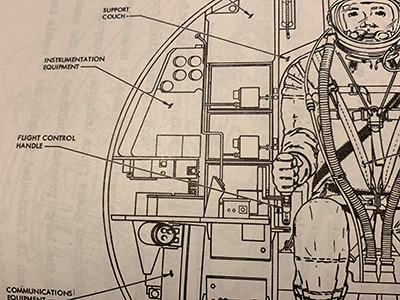 
|
Jim Behling
Member Posts: 1488
From: Cape Canaveral, FL
Registered: Mar 2010
|
 posted 05-07-2019 10:27 AM
posted 05-07-2019 10:27 AM
   
quote:
Originally posted by MOL:
As far as I know, the only three axis control stick was in the astronaut's right hand.
You are right. I was mixing up the two sticks of the X-15 with the multiple control modes of the Mercury right hand controller. |
PeterO
Member Posts: 402
From: North Carolina
Registered: Mar 2002
|
 posted 05-07-2019 03:41 PM
posted 05-07-2019 03:41 PM
   
Here are photos of the explosive hatch and plunger, which I took at the Liberty Bell 7 exhibit at the Boston Museum of Science in 2002.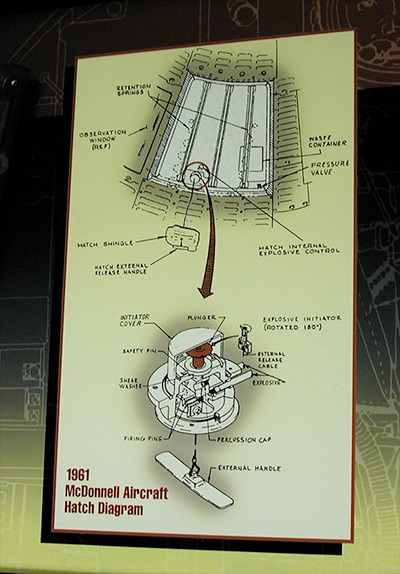 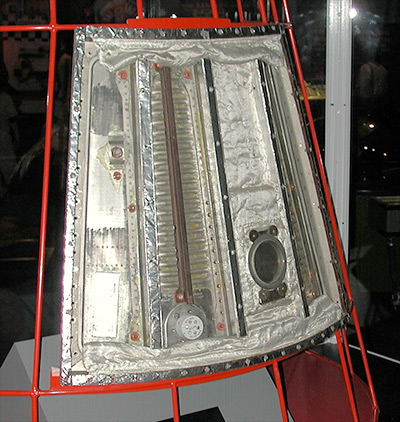

|
Explorer1
Member Posts: 180
From: Los Angeles, CA, USA
Registered: Apr 2019
|
 posted 05-08-2019 02:24 AM
posted 05-08-2019 02:24 AM
  
Thank you for all of the great responses. Regarding the hatch picture with the plunger mechanism, where was the plunger mechanism positioned relative to the astronaut's reach? It appears that when the astronaut was on his back that the plunger mechanism would be above his head. Once the safety pin was removed it looks like it could be a very precarious mechanism to avoid if one wanted to delay activating it. Is this true?Also, in the last picture posted that shows the interior of the hatch and the plunger mechanism to its left is that a twist or crank handle mechanism for opening the hatch as well? In other words, did the Mercury astronauts on later flights have the option of cranking open the hatch as well as using the plunger mechanism? |
Jim Behling
Member Posts: 1488
From: Cape Canaveral, FL
Registered: Mar 2010
|
 posted 05-08-2019 06:24 AM
posted 05-08-2019 06:24 AM
   
quote:
Originally posted by Explorer1:
...did the Mercury astronauts on later flights have the option of cranking open the hatch as well as using the plunger mechanism?
No, only the plunger. |
oly
Member Posts: 971
From: Perth, Western Australia
Registered: Apr 2015
|
 posted 05-08-2019 07:57 AM
posted 05-08-2019 07:57 AM
   
As a point of design interest, the Mercury capsule design that utilized the explosive bolts to secure the hatch was not designed for the astronaut to operate in normal conditions, the plunger inside was designed for emergency use. There was also a lanyard outside the capsule that recovery divers could pull to initiate the hatch system, also originally designed for use in an emergency.The primary system design utilized a pressure switch on the recovery loop. When the pressure created by the recovery helicopter’s hoisting cable, hooked onto the loop, began to raise the capsule, the mechanism fired, and blew the hatch off. The system had to be armed by the astronaut when ready for recovery by selecting the system switch to armed. |
Explorer1
Member Posts: 180
From: Los Angeles, CA, USA
Registered: Apr 2019
|
 posted 05-08-2019 08:29 AM
posted 05-08-2019 08:29 AM
  
quote:
Originally posted by PeterO:
Here are photos of the explosive hatch and plunger...
Could I trouble you to explain the differences in pictures 2 and 3 that you posted of the hatch? The two pictures look quite different. Is picture 3 a panel covering that goes over what we are seeing in picture 2?And can you tell me what the large rectangular item is to the left of the plunger in picture 3? It looks similar to the hatch handle that was used on Shepard's flight. |
PeterO
Member Posts: 402
From: North Carolina
Registered: Mar 2002
|
 posted 05-08-2019 08:56 AM
posted 05-08-2019 08:56 AM
   
The first photo shows the outside of the hatch, and the second shows the inside. The black exterior shingles were not part of the pressure hatch, and were installed after the hatch was bolted in place. These pages (below) are from the Mercury Maintenance Manual.I don't recall what the large rectangular box was, but it appears to be some sort of experiment that can be exposed to the vacuum on the outside. 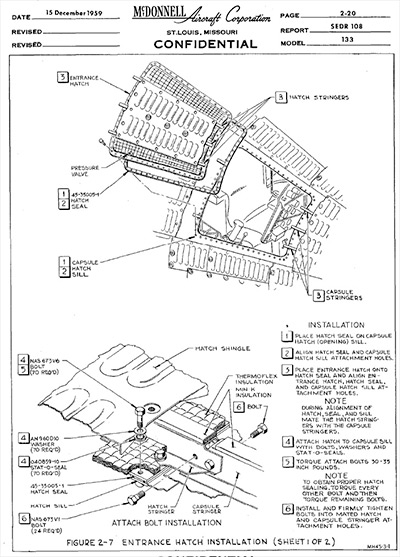 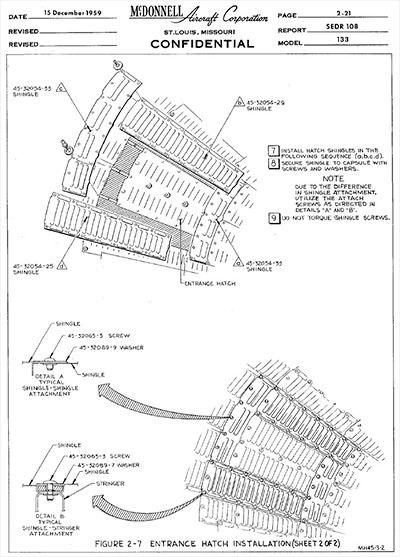
|
oly
Member Posts: 971
From: Perth, Western Australia
Registered: Apr 2015
|
 posted 05-08-2019 04:08 PM
posted 05-08-2019 04:08 PM
   
quote:
Originally posted by PeterO:
I don't recall what the large rectangular box was, but it appears to be some sort of experiment that can be exposed to the vacuum on the outside.
The decal affixed reads that it is a micro-meteorite sampler, made by Bendix. |
Explorer1
Member Posts: 180
From: Los Angeles, CA, USA
Registered: Apr 2019
|
 posted 05-08-2019 09:42 PM
posted 05-08-2019 09:42 PM
  
I have been curious to know how close the armed detonator was to Grissom's helmet. If I have his steps correct, then he removed his survival knife first, then armed the detonator, but did he remove his helmet before these steps or after? |
oly
Member Posts: 971
From: Perth, Western Australia
Registered: Apr 2015
|
 posted 05-09-2019 06:29 AM
posted 05-09-2019 06:29 AM
   
In the MR-4 post flight report Gus states that he opened the helmet face plate and disconnected the visor seal hose while descending on the main chute. following splash down, and after determining that the capsule was in a stable condition, he disconnected the oxygen outlet hose at the helmet and unfastened the helmet from the suit.After releasing the straps and harness, and the biomedical harness, he rolled the neck dam into position over the suit neck ring, leaving him connected to the spacecraft in two locations, the oxygen inlet hose, and the helmet coms lead. Next he released the hatch restraining wires at both ends and tossed them at his feet, removed the knife from the door and placed it in the survival pack, and removed the cover and safety pin from the hatch detonator. The next step was to instruct the helicopter to come in and hook onto the spacecraft, and confirm recovery procedures with the helo crew. Gus removed the oxygen inlet hose and waited for the crew instructions. While waiting, Gus admitted to considering if there was some way he could carry the knife with him as a souvenir. As the hatch suddenly blew, Gus found water spilling over the door sill, removed the helmet from his head and dropped it, reached for the right hand side of the instrument panel, and pulled himself clear of the spacecraft. The helmet was left on for as long as possible to facilitate radio coms. |
Explorer1
Member Posts: 180
From: Los Angeles, CA, USA
Registered: Apr 2019
|
 posted 05-12-2019 12:53 AM
posted 05-12-2019 12:53 AM
  
Thank you oly for the outline on Grissom's steps. Do you know where the survival pack was located in the capsule? And in wanting to carry the knife on him in some way, was his concern that the survival pack would be out of his possession once the capsule was retrieved? |
MOL
Member Posts: 102
From: Los Angeles, CA
Registered: Oct 2004
|
 posted 05-12-2019 10:17 AM
posted 05-12-2019 10:17 AM
   
Yes, if you scroll up in this thread to see the diagrams I posted from the spacecraft familiarization manual, you can see that the survival kit is labeled in a location just to the right of the astronaut’s left shoulder.. |
oly
Member Posts: 971
From: Perth, Western Australia
Registered: Apr 2015
|
 posted 05-13-2019 05:01 AM
posted 05-13-2019 05:01 AM
   
While the illustration indicates the survival kit location, I am unsure if this is the location for all Mercury flights.This 360 degree image shows that the area to the left of the astronaut had become filled with equipment, leaving the location to the right of the astronaut, between the couch and the main hatch, as the best available space. I remember reading that both the parachute and survival kit were stowed here on later flights, however, I can not find that citation at this time. During decent, the astronaut's prime concern was access to the parachute until the spacecraft altitude was low enough, and the main chutes were fully deployed and stable. The attention then turned to the survival kit, because it contains the life raft, survival gear and rations. If there was any requirements to bail out, it would be wise to take the kit with you, however time constraints and the ability to retain the kit probably inhibited the ability to do so. I am not sure if the kit was tethered to the astronaut, as ejection seat survival kits can be. It would also be a feat trying to move the survival kit through the emergency exit and be able to manipulate and deploy the life raft in rolling seas. |
PeterO
Member Posts: 402
From: North Carolina
Registered: Mar 2002
|
 posted 05-13-2019 08:45 AM
posted 05-13-2019 08:45 AM
   
My recollection is that only Freedom 7 carried a pilot's parachute. The capsule already had a backup parachute, so the astronauts felt another backup was unnecessary. As you said, the opportunity to use the parachute was very limited and difficult in any case.Sigma 7 had a "ditty bag" above Schirra's right shoulder next to the hatch, which was used to store the camera, film magazines and other items. To the left of the couch was a large flat bag. My guess is that it contained both the survival kit and the life raft. [On Edit] The same bag shows in the 360 panorama of Friendship 7. Carpenter exited through the parachute section after landing downrange, and was able to deploy the raft and survival kit. |
mercsim
Member Posts: 219
From: Phoenix, AZ
Registered: Feb 2007
|
 posted 05-13-2019 01:04 PM
posted 05-13-2019 01:04 PM
   
You can see Gus's parachute inside Liberty Bell 7. quote:
Originally posted by oly:
The primary system design utilized a pressure switch on the recovery loop. When the pressure created by the recovery helicopter’s hoisting cable, hooked onto the loop, began to raise the capsule, the mechanism fired, and blew the hatch off.
I would like to see a photo of this or reference in the Familiarization manual. I have hundreds of photos of this recovery section of many of the capsules and don't recall anything like this. I am getting old so may have forgotten it. |
oly
Member Posts: 971
From: Perth, Western Australia
Registered: Apr 2015
|
 posted 05-13-2019 10:23 PM
posted 05-13-2019 10:23 PM
   
quote:
Originally posted by mercsim:
I would like to see a photo of this or reference in the Familiarization manual.
As I wrote above, this was a point of interest about the primary design. Engineers determined that this system had many design flaws, there was a requirement for the system to be armed when the capsule was clear of the water. If the system was armed prior to this, there was a chance that the hatch could be blown while still below the water line. During Shepard's flight, it took some time for the capsule to be hoisted clear of the water, before he could unlatch the hatch. The automation was removed from the design during production development, and the manual detonation of the hatch became the method of operation. Of the five Mercury flights that used the explosive hatch system, three different recovery methods were used. Grissom from the water, Glenn, Schirra and Cooper exited the capsule on the ship's deck, Carpenter from his life raft at sea. Glenn was originally meant to climb out the top hatch. |
mercsim
Member Posts: 219
From: Phoenix, AZ
Registered: Feb 2007
|
 posted 05-14-2019 10:57 PM
posted 05-14-2019 10:57 PM
   
The point of design interest was about explosive bolts. Then you said the primary system design used a switch.Again, where did you get this information from? |
oly
Member Posts: 971
From: Perth, Western Australia
Registered: Apr 2015
|
 posted 05-15-2019 01:09 AM
posted 05-15-2019 01:09 AM
   
Perhaps, while trying to offer up what I thought would be a useful aside point of interest, I should have used the word initial, rather than primary. This may have avoided any confusion of frustration.My reference for this information comes from a collection of vintage engineering papers that I have scanned copies of, some of which were written by engineers working on the early spacecraft designs. I apologise for not being able to provide document numbers or direct quotes, many of the document copies as early scans that are PDF images and are not electronically searchable. While many here collect space-related patches, hardware, and other items of interest, I collect technical documents and engineering drawings. It is a habit from undergrad studies that somehow turned into a collection. I did not make an immediate reference to these documents prior to offering up this information, in fact, it has been some time since I have read many of them, and admit to only using memory as a reference. I apologise for doing so. It appears that if memory has failed me this time, it is an inexcusable error on my part. The point of interest regarding the design was in regard to a system of actuation of the explosive bolts (that was never adopted). As my belief was that readers of this topic have access to familiarisation and operations manuals, as well as other available documentation, and may find some additional information interesting. I also considered that readers were aware of the different modes of egress that were carried out during each Mercury mission, none of which incorporated the system I described. |
Lou Chinal
Member Posts: 1332
From: Staten Island, NY
Registered: Jun 2007
|
 posted 06-15-2019 05:18 PM
posted 06-15-2019 05:18 PM
   
quote:
Originally posted by mercsim:
You can see Gus's parachute inside Liberty Bell 7.
Grissom also carried a chest type parachute. |
robertsconley
Member Posts: 59
From: Meadville, PA
Registered: Jun 2005
|
 posted 06-20-2019 03:06 PM
posted 06-20-2019 03:06 PM
   
If you want the majority of the details on the joystick and how it worked. I suggest downloading the Mercury Familiarization Manual and the Mercury Maintenance Manual.It is found in section 4 in both manuals. If want more technical documentation. You can find it here. I have a more concise explanation of this on page 12 to 16 of the Project Mercury add-on manual I wrote a while ago for the Orbiter Space Simulator. |


















